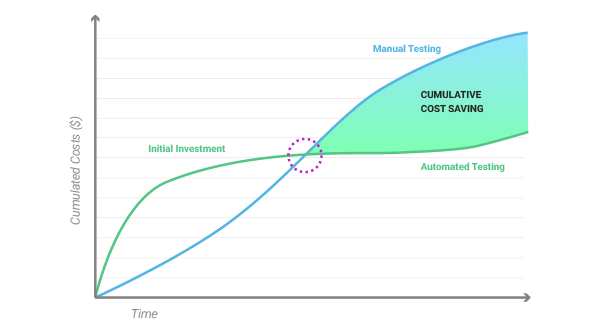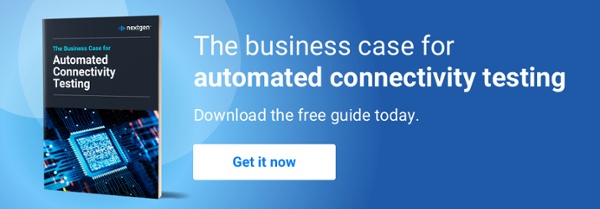Calculating the ROI of Test Automation for Product Development
How to Measure the ROI of Test Automation for Product Development
In product development, where speed is king, quality assurance (QA) teams find themselves under increasing pressure. As test automation comes increasingly to the forefront, the need to strike a balance between rapid product releases and superior quality has never been more important. For QA or product development teams considering the switch to a test automation strategy, understanding the potential ROI is crucial.
Benefits of Automated Testing
Switching to automated testing boasts a range of key advantages:
- Consistency and Methodology: Automated tests provide a uniform testing method, ensuring consistent results each time.
- Depth of Testing: Automation avoids the limitations of manual testing, offering an greater coverage and depth.
- Rapid Fault Detection: Automation leads to faster error detection, reproducibility of bugs and subsequent resolution.
- Cost Efficiency: While there's an upfront investment, the long-term savings are substantial.
- Quality and Customer Retention: Higher product quality translates to higher customer satisfaction and builds brand equity for the company.
- Round-the-Clock Testing: Automated systems can run tests 24/7, irrespective of time zones.
- Market Adaptability: Test automation can cater to global product variants and regionalisation aspects with ease.
- Enhanced Market Position: Quicker test cycles provide a competitive edge and faster time to market.
- Quality at Speed: Automation ensures high quality without compromising on delivery speed.
- Balance: Test automation can provide the perfect balance between speed and product stability.
However, making the case for automated testing still requires rigour and financial insight.
Understanding the Importance and Calculation of ROI in Automated Testing
The ROI of your test automation investment isn't just a number; it's an indicator of strategic success. Proving this ROI becomes a central conversation when building a business case for the ROI of QA test automation.
To calculate ROI, we must weigh the costs of implementing product test automation against the accrued benefits. This equation can be outlined as:
ROI = (Net Cost savings / Net Investment cost) x 100
However, this formula varies depending on company specifics. Savings are often measured in terms of QA time saved, while investments could fluctuate based on whether automation is in-house or outsourced.

ROI Expectations and Types of ROI Calculations
Setting the right expectations is key. Initially, automation might appear costly due to financial, implementation and training investments. However, these costs tend to plateau with enhanced operational efficiency building over time. Conversely, the expenses associated with manual testing remain relatively constant.
ROI can be viewed from multiple angles:
- The overall value derived from automated testing.
- Expenses linked to the introduction of new automated tests.
- The cost of automating regression tests.
- Advanced considerations, such as defect leakages or the potential redundancy of tests.
Challenges in ROI Calculation
While automation increases testing speed, manual testing, being comparatively slower, can inadvertently impact other sectors like sales or marketing. And as regression tests become more convoluted over time and product development lifecycle, they consume additional time when done manually, to the point at which all required regression testing may become manually impossible.
It's essential to acknowledge that automation isn't a one-size-fits-all solution. Calculating both immediate and future ROI, maintaining automated tests, and ensuring robust documentation are key to avoiding potential pitfalls.

Implementation Tips and Best Practices
Guidelines for transitioning to automation:
- Look for scalable, user-friendly platforms. Modern codeless platforms, and those leveraging AI, expedite the implementation process and reduce training costs.
- A mixed-method approach accommodating both manual and automated tests is often the most efficient.
- Continuous management and upkeep of test cases is imperative.
- Hidden costs, such as training, should be factored into your ROI calculations.
- A phased introduction coupled with strategic foresight can steer the direction of your test automation implementation strategy.
- Before automating any process, thorough evaluation is essential. Remember, today's new test could be tomorrow's regression test. Adjust your testing model accordingly.
When making the business case for investing in automated testing , it's important to consider these factors.
Gaining Support and Documentation
While making the case for test automation, transparency is key. Clearly detailing costs, processes, and the projected ROI can ease stakeholder apprehensions. Comprehensive documentation not only aids in procuring the necessary investment but also serves as an resource when the test automation strategy is implemented, safeguarding against knowledge loss and building a long term test automation resource.
As the momentum towards test automation grows, understanding and demonstrating its ROI becomes a central conversation for QA and product development teams. With the right strategy, tools, and foresight, test automation can prove to be a game-changer in product development.
Nextgen ATAMConnect should be on your automation short list
Nextgen's ATAMConnect offers a streamlined codeless automation suite, accelerating stress testing by simplifying the creation and execution of tests. This enables QA teams to swiftly identify potential issues, reducing the product's time to market. Its user-friendly design caters to individuals across different technical backgrounds, promoting collaboration and lessening the reliance on specialised coding expertise. Discover more about ATAMConnect's advantages by exploring our case studies or contact us to chat with an automation expert.




